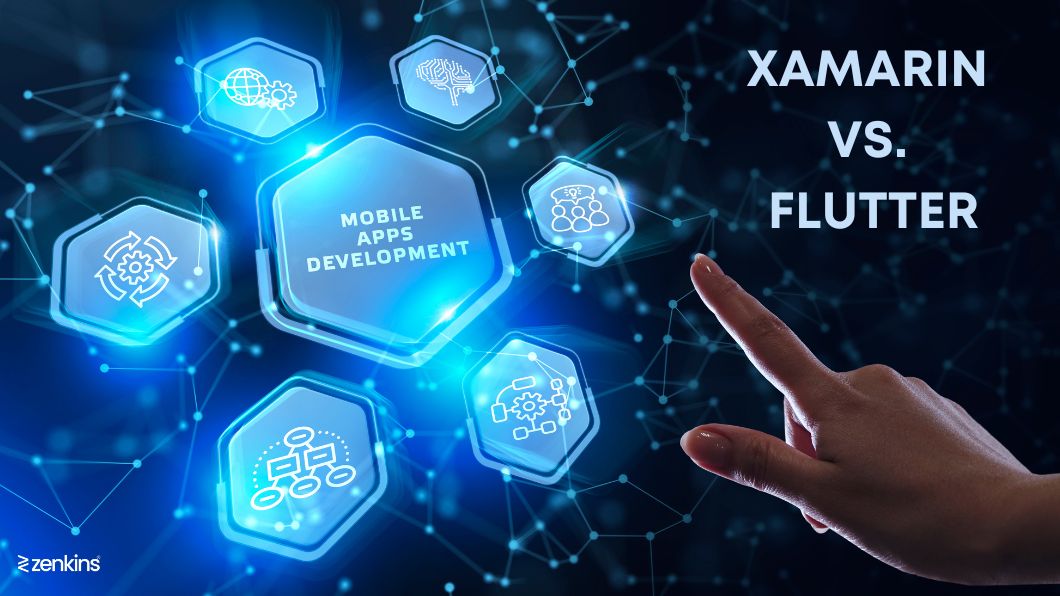Hybrid Hustle: Xamarin vs. Flutter for Building Cross-Platform Mobile Apps
Table of Contents
In today’s digitally-driven world, the demand for mobile applications has skyrocketed, prompting businesses and developers to find efficient ways to build apps for multiple platforms simultaneously. This need has paved the way for cross-platform mobile app development frameworks like Xamarin and Flutter. In this article, we will delve into the world of hybrid hustle, comparing Xamarin and Flutter as powerful tools for building cross-platform mobile apps. By understanding the benefits, drawbacks, and key differences between these frameworks, developers and businesses can make informed decisions about which approach best suits their project requirements and goals. So, let’s embark on this journey to explore the realm of Xamarin and Flutter for cross-platform app development.
Introduction: Exploring the Need for Cross-Platform Mobile App Development
Rise of Cross-Platform App Development
In today’s digital world, mobile apps have become an essential part of our lives, whether it’s for ordering food, booking travel, or staying connected with friends and family. As the demand for mobile apps continues to grow, developers are faced with the challenge of creating applications that can run seamlessly on multiple platforms.
Traditionally, developers had to build separate apps for iOS and Android, using different programming languages and tools. However, with the rise of cross-platform app development, they now have the option to write code once and deploy it on multiple platforms. This approach saves time and resources, making it an attractive solution for businesses and developers alike.
Benefits and Challenges of Cross-Platform Development
Cross-platform development offers several benefits. First and foremost, it allows developers to reach a wider audience by releasing their apps on multiple platforms simultaneously. This boosts user engagement and helps businesses stay ahead of the competition.
Furthermore, cross-platform development streamlines the development process by enabling code sharing between platforms. Developers can write the majority of the codebase once, reducing the overall development time and effort. This approach also simplifies maintenance and updates, as changes can be applied across all platforms with a single codebase.
However, cross-platform development is not without challenges. One of the main concerns is performance, as cross-platform frameworks often need to bridge the gap between native code and the underlying operating systems. Additionally, some platform-specific features and design elements may not be fully accessible through cross-platform development.
Click here to explore mobile app development services!
Understanding Xamarin: Pros and Cons
Overview of Xamarin
Xamarin is a cross-platform framework that allows developers to build native mobile apps using C#. It leverages the .NET platform and integrates seamlessly with Visual Studio, making it an attractive choice for developers already familiar with Microsoft technologies.
Advantages of Xamarin
One of the key advantages of Xamarin is its ability to share code across different platforms, resulting in faster development cycles and reduced maintenance efforts. With Xamarin, developers can achieve close-to-native performance and access platform-specific APIs, ensuring a rich and powerful user experience.
Moreover, Xamarin benefits from a large and active community, offering extensive documentation, libraries, and plugins. This wealth of resources facilitates learning and problem-solving, making it easier for developers to get up to speed and create robust applications.
Limitations and Challenges of Xamarin
Despite its strengths, Xamarin does have some limitations. For starters, the full potential of Xamarin can only be unlocked with a paid license, making it less suitable for small-scale projects or individual developers on a budget. Additionally, as Xamarin integrates with platform-specific APIs, it is crucial to stay updated with changes in those APIs to ensure compatibility.
Another challenge is the learning curve. While Xamarin uses C#, developers still need to familiarize themselves with the Xamarin framework and the platform-specific nuances. This learning process can be time-consuming, especially for developers coming from different programming backgrounds.
Exploring Flutter: Advantages and Disadvantages
Overview of Flutter
Flutter is an open-source UI toolkit developed by Google for building natively compiled applications for mobile, web, and desktop from a single codebase. It uses the Dart programming language and provides a rich set of pre-designed widgets, enabling developers to create visually appealing and interactive user interfaces.
Benefits of Flutter
Flutter offers several advantages, starting with its ability to create visually stunning and highly customizable user interfaces. With Flutter’s hot reload feature, developers can see instant changes in the UI during the development process, making it easier to iterate and refine the app’s design.
Another notable advantage of Flutter is its performance. It utilizes a “skia” rendering engine, which allows Flutter apps to achieve near-native performance across different platforms. This results in smooth animations, fast loading times, and a responsive user experience.
Drawbacks and Considerations of Using Flutter
Despite its strengths, Flutter also has some drawbacks. As an emerging framework, Flutter has a relatively smaller community compared to more mature frameworks like Xamarin. While the community is growing rapidly, it may still be more challenging to find comprehensive resources and support for specific issues.
Moreover, Flutter’s reliance on a single language, Dart, could be viewed as a limitation for developers who are more comfortable with other programming languages. Although Dart is relatively easy to learn, developers may need to invest some time in upskilling to make the most out of Flutter.
Key Differences: Xamarin Vs. Flutter for Cross-Platform App Development
Language Options: C# vs. Dart
Xamarin utilizes C#, a widely used programming language with a large developer community. This familiarity makes it easier for developers to transition into Xamarin. On the other hand, Flutter relies on Dart, a language specific to the framework. While Dart is easy to learn, developers may need some adjustment time if they are not already familiar with it.
Framework Architecture: Native vs. Reactive
Xamarin follows a native framework architecture, allowing developers to access platform-specific APIs and features directly. This results in a more native-like performance and user experience. In contrast, Flutter follows a reactive architecture, where the UI is built using pre-designed Flutter widgets. This architecture promotes a UI-centric approach and allows for fast iterations, but may have slightly different behavior and performance characteristics compared to native applications.
Development Environment and Tooling
Xamarin integrates seamlessly with Microsoft’s Visual Studio, providing a familiar and robust development environment for developers. It also offers extensive debugging and testing capabilities. Flutter, on the other hand, provides its own command-line interface and supports popular editors like Visual Studio Code. While Flutter lacks the seamless integration with Visual Studio, it offers a lightweight and efficient development experience.
Evaluating Performance, User Interface, and User Experience: Xamarin vs. Flutter
Performance Comparison
When it comes to performance, both Xamarin and Flutter have their strengths. Xamarin, being built on top of the .NET framework, offers excellent performance and can leverage the native capabilities of the underlying platform. On the other hand, Flutter uses its own rendering engine and is known for its smooth animations and fast UI updates.
Ultimately, the performance of your app will depend on various factors such as the complexity of the application, the efficiency of your code, and the optimization techniques employed. It’s worth noting that Xamarin, being closer to the native platform, may have a slight edge in terms of raw performance.
UI Development and Customization
When it comes to UI development and customization, Flutter takes the cake with its flexible and expressive UI framework. With Flutter, you can create beautiful and pixel-perfect interfaces using its extensive set of widgets and rich customization options.
Xamarin, on the other hand, relies on platform-specific UI controls, which means you have access to the native UI elements of each platform. While this may provide a more consistent look and feel across different devices, it can also limit the level of customization you can achieve.
Both frameworks offer ways to create custom UI components, but Flutter’s approach is more straightforward and allows for more creativity.
User Experience Considerations
User experience is a critical aspect of any mobile app. Xamarin allows you to create native user interfaces, which means your app will have a familiar look and feel to users on each platform. This can enhance the overall user experience, as it aligns with the native standards and conventions.
Flutter, on the other hand, follows its own design principles and has a distinctive look that sets it apart. While it may not provide the same level of native familiarity, Flutter’s UI framework offers a consistent and visually appealing experience across different platforms.
Ultimately, the choice between Xamarin and Flutter for user experience considerations will depend on your target audience, the design requirements of your app, and the importance of adhering to platform-specific guidelines.
Choosing the Right Framework: Factors to Consider for Your Cross-Platform Mobile App Development
Project Requirements and Goals
When choosing between Xamarin and Flutter, it’s crucial to consider your project requirements and goals. If your app requires deep integration with specific platform features or relies heavily on platform-specific APIs, Xamarin might be the better choice due to its strong native bindings and access to platform APIs.
On the other hand, if you prioritize a consistent UI/UX across multiple platforms and value rapid development, Flutter’s cross-platform approach and hot-reload feature can significantly speed up the development process.
Developer Skill Set and Learning Curve
Another factor to consider is the skill set of your development team. If your team is already proficient in C#, .NET, and familiar with the Xamarin ecosystem, adopting Xamarin might be a smooth transition. However, if your team has experience with Dart or web development, Flutter’s declarative UI and reactive programming model might be easier to grasp.
It’s essential to evaluate the learning curve and assess the availability of resources (tutorials, documentation, and community support) for both frameworks based on your team’s proficiency.
Community Support and Ecosystem
The strength of the community and the availability of third-party libraries, plugins, and tools can greatly impact the development experience and the success of your project.
Xamarin has been around for a longer time and boasts a mature and extensive ecosystem with a vast community of developers. This means you have a wealth of resources, plugins, and libraries at your disposal.
Flutter, although relatively new, has gained significant traction and is backed by Google. Its community is growing rapidly, and it has a dedicated set of packages and tools provided by the Flutter team and the wider community.
Considering the ecosystem and community support is crucial as it can save development time and provide solutions to common challenges.
Case Studies: Real-World Applications of Xamarin vs. Flutter
Successful Xamarin Apps
Xamarin has been used to build successful apps across various industries. Some notable examples include Slack, Pinterest, and The World Bank’s Survey Solutions.
Noteworthy Flutter Applications
Flutter has also seen its fair share of notable applications. Some noteworthy examples include the Google Ads app, Reflectly (a popular journaling app), and Hookle (a social media management app).
Conclusion: Making an Informed Decision for Your Cross-Platform App Development
Choosing between Xamarin and Flutter for cross-platform app development requires careful consideration of multiple factors. Evaluating performance, UI development, user experience, project requirements, developer skill set, and community support are crucial steps in making an informed decision.
Ultimately, Xamarin offers a more native and familiar experience with excellent performance, while Flutter provides a fast development workflow, expressive UI, and a consistent look and feel across platforms. Both frameworks have their strengths and are capable of building high-quality cross-platform apps. The final choice depends on your specific project needs, team expertise, and personal preference.
In conclusion, both Xamarin and Flutter offer compelling options for cross-platform app development. Xamarin, with its strong ties to the Microsoft ecosystem and access to native APIs, is a solid choice for developers already comfortable with C#. On the other hand, Flutter’s visually appealing UI, near-native performance, and hot reload feature make it a popular choice for developers looking for a more streamlined and efficient development workflow. Ultimately, the decision between Xamarin and Flutter depends on specific project requirements, developer preferences, and the target audience.
FAQ
What is cross-platform mobile app development?
Cross-platform mobile app development refers to the process of building mobile applications that can run on multiple platforms, such as iOS and Android, using a single codebase. This approach allows developers to write code once and deploy it across different platforms, saving time and resources compared to developing separate native apps for each platform.
What are the advantages of using Xamarin for cross-platform app development?
Xamarin offers several advantages for cross-platform app development. It allows developers to write code in C#, a widely-used programming language, and provides access to a vast library of native APIs and UI controls. Xamarin also offers excellent performance as it compiles down to native code, resulting in app performance comparable to native apps. Additionally, Xamarin benefits from a large and active community, providing extensive support and resources for developers.
How does Flutter differ from Xamarin in terms of user interface development?
One distinguishing feature of Flutter is its UI development approach. Flutter uses a reactive and declarative UI framework, where the entire UI is rendered as a widget tree. This allows for fast and flexible UI development and enables developers to create visually stunning and customizable user interfaces. On the other hand, Xamarin follows a more traditional native UI approach, utilizing platform-specific UI components and language bindings.
Can I migrate an existing Xamarin app to Flutter?
While it is possible to migrate an existing Xamarin app to Flutter, it requires rewriting the codebase in Dart, the programming language used by Flutter. The decision to migrate depends on various factors such as the complexity of the app, the resources available, and the desired benefits of moving to Flutter. It is recommended to carefully evaluate the pros and cons before committing to a migration.






